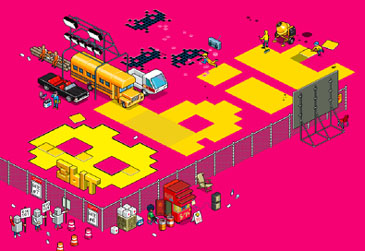View current page
...more recent posts
More on the movie 8 BIT, opening this weekend at MOMA. The interview below is cobbled together from email questions Paddy Johnson sent me in connection with her Reeler article, and my responses:
PJ: Do you see yourself, and does the movie portray you as an artist working within the genre who is a counterpoint to a generation who has grown up with these influences? I would imagine that from this perspective your position as an artist and a critic would be key.
TM: My interview footage is used a number of times in the film. It's the wonky side of me that you see on my blog, analyzing, historicizing, and kibbitzing about others' work, mostly. (Sure to win me more friends!)
The movie title "8 BIT"--referring to a type of computer memory used in older machines--applies to art and music made with videogames, which the movie focuses on, but also the "lo-fi" tendency in new media art.
At one point in the film, Cory Arcangel talks about the different types of sounds that come out of different '80s computers. He and and the BEIGE crew used those sounds to make classic "electro" tunes that were not "videogame art" per se, but music proactively using the limitations of that old gear.
Working at the low end of computing is a kind of resistance to, or critique of, the high end--the ubiquitous domain of company-employed, non-artist experts.
The DIY, hacker, guerrilla mindset is a constant theme in the movie--the topic is bigger than videogames. One thing I like about the film is it casts its net wider than just a small scene.
PJ: One of the threads that runs through the movie is that because the medium is so new, we are still figuring out how to work with it. You briefly describe a progression of games pointing out that at each point along this time line artists could respond to the technology, but we haven't had enough time to deal with it all. This is very true, and the issue is compounded, I think, by the fact that technology changes so quickly that you can't respond to all of it. It seems to me one of the challenges new media faces is figuring out how to create work that has permanence in a medium that is constantly changing. Do you think this is happening?
TM: New media artists are fairly attuned to issues of what's gained or lost in the constant process of "updating" software and hardware. A lot of the in-jokes deal with the outmoded (Pong, MacPaint) or not-yet-moded (e.g., "vaporware"). The problem is arriving at a consensus of what's good and bad in the *art* (as opposed to just the tech), and then how to present this to the broader art world. That's where blogs are useful--these issues can be hashed out. I feel like I've found a peer group through blogging and the Net, which is overall more open and verbal than what I found with my peers in the art world. Films like 8 BIT are also helpful in defining the values of a "scene." What should be in the movie? What shouldn't? I've often said that since artists are not "joiners" by nature (i.e., they are self-absorbed holy terrors), when two or more of them agree on something it's usually significant. Then the rest of the world has to catch up.
PJ: Well, from that standpoint, I think this is an important movie for New Media, because it will help people understand how artists come to make the work they are making. For instance one of the commonalities among almost all of the artists was their interest in creating limitations and then working within these perimeters. Is this something that you feel is a result of the bias of the medium (in other words, programming requires a certain kind of thought process, so this desire stems from an interest in the way the medium works in the first place) or a larger cultural construct? Does this way of working influence your studio practice in any way?
TM: As for the larger cultural construct, yes, as I touched on earlier it's a kind of resistance to the more obnoxious principles of Modernity--planned obsolescence, buying new gear to keep up with the neighbors, proprietary software that controls you rather than the reverse--while still working with materials and processes that have something to do with the era you live in.
On a practice level, let's go back to the example of the '80s computer sounds the BEIGE crew's 8-Bit Construction Set record. One reason for using the older Atari and Commodore computers is that the sounds are excellent--gravelly, squelchy, very distinctively "low-res." Newer gear "improved" and got rid of some of those.
 I use an older version of the Windows MSPaint software to make artwork and animated GIFs. Partly I'm being "office ironic," but the program had a particular way of doing pixelated crosshatching that was "improved" in subsequent versions and lost. I don't use the program because it's older, but because it's actually better. These sound like "formal" issues, but a particular look or sound can be very important to an artist's work.
I use an older version of the Windows MSPaint software to make artwork and animated GIFs. Partly I'm being "office ironic," but the program had a particular way of doing pixelated crosshatching that was "improved" in subsequent versions and lost. I don't use the program because it's older, but because it's actually better. These sound like "formal" issues, but a particular look or sound can be very important to an artist's work. PJ: In the movie you talk about Game Boy music being tuneless, which of course upset a bunch of Game Boy musicians. Immediately following angry musician footage is a clip allowing you explaining that point further. But this clip consists merely of "What I meant by that is it's not interesting melodically." I thought it was an interesting editing choice, as I am guessing you had more to say on the point than this, it probably connected these thoughts on Atari and Commodore computers. Is this the case?
TM: Game Boy music was declared the "next big thing" by Malcolm McLaren, promoter of the Sex Pistols, a few years back. Just to be clear, because it may be a little confusing in the film, my comments didn't apply to all "8-Bit" style music or "chiptunes." Just the Game Boy subset of it--which gets its own section in the 8 BIT movie.
The Game Boy is more limited as a music-making device than say, the Commodore 64 chip, which has analog filters, ADSR (sound envelope) shapers, etc. It's a 4-bit, 4-channel sound chip, and almost all the music is made on it is done with the interface designed by the Swedish musician/hacker Role Model. The music's cute, but too much of it sounds like...a Game Boy, or worse, somebody randomly pecking around the keyboard. (Bit Shifter is, I'm told, the Segovia of Game Boy music, but I keep missing his performances.)
By contrast, what the BEIGE crew and Tree Wave do with the Commodore and the Atari is rich and complex--hacking the sound chips (or not) to make music with a greater range and a fuller sound in a performance context. Bodenstandig 2000 also shows the extremes of what can be done with chips and tracker interfaces--really nasty drum and bass, among other things.

In The Reeler this week Paddy Johnson reviews the movie 8 BIT, opening Saturday at the Museum of Modern Art. I'm in the film yakking a lot so this will be 8-Bit Week here at the blog. I'll post some back-and-forth email Johnson and I had re: the review (with her kind permission), and will give my own biased perspective on the film. Johnson notes that it's "the first movie of its kind to document and situate the 8-bit scene within contemporary art discourse," and quotes me as saying "the DIY (do it yourself), hacker, guerrilla mindset is a constant theme... One thing I like about the film is it casts its net wider than just a small scene." Meaning it encompasses a variety of lo-fi strategies for using the computer as an art making tool.
But what exactly does "8-bit" mean? In computing it can connote "small," "low res," or "old"--the second meaning interests me the most. Wikipedia says: "In computer architecture, 8-bit integers, memory addresses, or other data units are those that are at most 8 bits (1 octet) wide. [...] The Z80 and the MOS Technology 6502 8-bit CPUs were widely used in home computers and game consoles of the 1970s and '80s. Many 8-bit CPUs or microcontrollers are the basis of today's ubiquitous embedded systems.
"There are 28 (256) possible permutations for 8 bits.
"About 55% of all CPUs sold in the world are 8-bit microcontrollers or microprocessors."
It's about doing a lot with a little to reach the most, as I see it.
MOMA 8 BIT page
8 BIT website
image above is a detail from the poster by eBoy.
